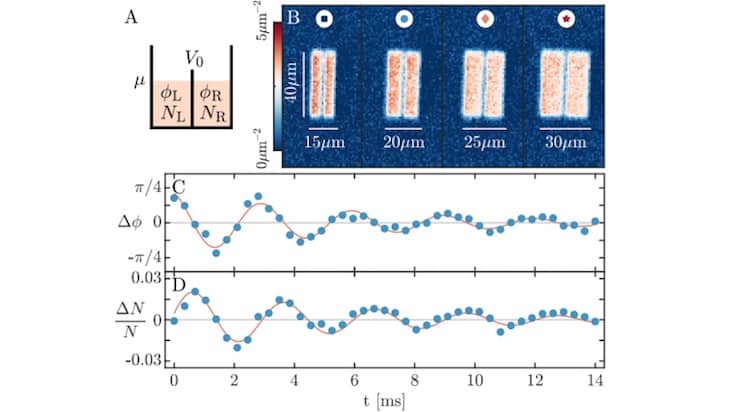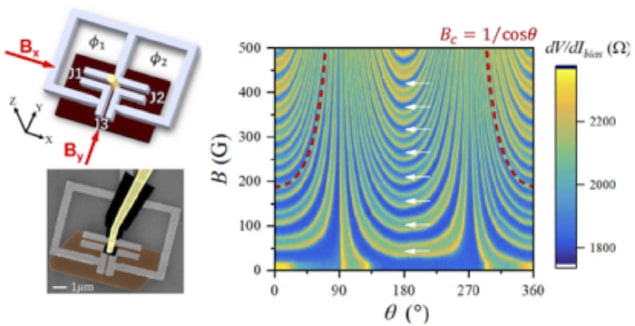Since then, Josephson junctions have found numerous applications. Superconducting quantum interference devices (SQUIDs), for example, are highly sensitive magnetometers, and use either one or two Josephson junctions depending on their design. Josephson junctions are also key components in superconducting qubits, which have at their heart a loop of superconducting material broken by one or two such junctions.
The Josephson effect
The supercurrent Is in an ordinary Josephson junction follows the relation Is=Ic sinj, where Ic is the critical supercurrent of the junction and j is the phase difference across it. However, this straightforward version of the Josephson effect does not apply to certain situations. For example, if the supercurrent in the junction is mediated by special bound states in materials with spin-orbital coupling (a relativistic interaction between an electron’s spin and its motion), the supercurrent can acquire an additional phase shift j0, explains Li Lu, who led the Beijing team’s research. This phase shift leads to the appearance of the AJE, in which Is is instead equal to Ic sin(j+j0).
The AJE is difficult to study because distinguishing which part of the total phase shift is caused by the conventional Josephson mechanism and which part is caused by the AJE is no easy task. One way to do it, Lu explains, is to tune the spin-orbital coupling using an applied gate voltage and therefore identify the j0. Another is to use a reference apparatus on the same device to tease out the relative contributions of the normal and anomalous phase shifts.
In the new work, Lu and colleagues identified the existence of such an anomalous phase shift in a three-way Josephson junction, or trijunction, based on bismuth selenide (Bi2Se3). This material is a topological insulator, meaning that while the bulk material is an electrical insulator, it conducts electrons extremely well on its surface thanks to special, topologically protected electronic states. Electrons in these states travel forward without backscattering, which allows them to carry electrical current without dissipating much energy. For this reason, topological materials are promising candidates for future energy-efficient electronic devices.
Anomalous phase shift
The trijunction studied by Lu’s team contains two single junctions aligned in one direction and third junction aligned perpendicular to the first two, forming a T shape. The researchers found that in this junction, exotic particles known as Majorana bound states behave differently when an in-plane magnetic field is applied parallel to the two inline single junctions, compared to when it is applied parallel to the third. From this behaviour they were able to unambiguously identity the anomalous phase shift and hence the AJE.
The behaviour of these Majorana bound states was predicted back in 2008 by Liang Fu and Charles Kane, who suggested that Josephson trijunctions based on topological insulators could serve as the building blocks for braiding so-called “Majorana zero modes”. Such modes should show up as peaks (technically termed zero bias conductance peaks) in the spectra of electrons tunnelling across the junction. They are also the core ingredient of topological qubits, which could provide a stable and fault-tolerant building block for quantum computing because these special modes are resistant to disturbances caused by external noise.

2D Fermi gas hosts ideal Josephson junction
Lu says that the AJE he and his colleagues have observed could serve as an additional knob for controlling the Majorana zero modes via an in-plane magnetic field. In their work, the researchers fabricated Josephson trijunctions based on three-dimensional Bi2Se3 and connected the terminal of the junctions with the superconducting loops in the structure. They then used the out-of-plane magnetic flux in the loops to control the phase difference in the trijunctions.
“With this approach, we were able to experimentally verify the behaviour of the Majorana phase diagram predicted by Fu and Kane,” Lu tells Physics World. “We further found that by applying an in-plane magnetic field, the whole Majorana phase diagram shifts in phase space thanks to the AJE induced by the in-plane magnetic field.”
The researchers, who detail their work in Chinese Physics Letters, are now looking into possible applications of the AJE in manipulating the Majorana zero modes in the trijunctions they studied.

